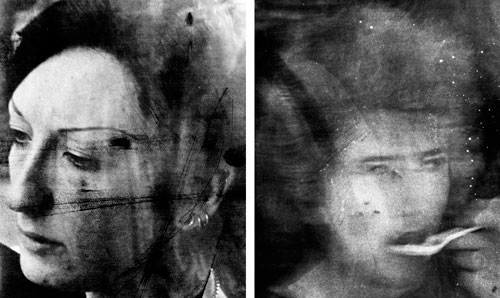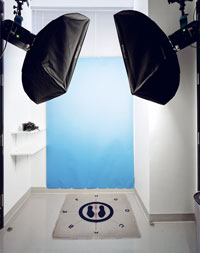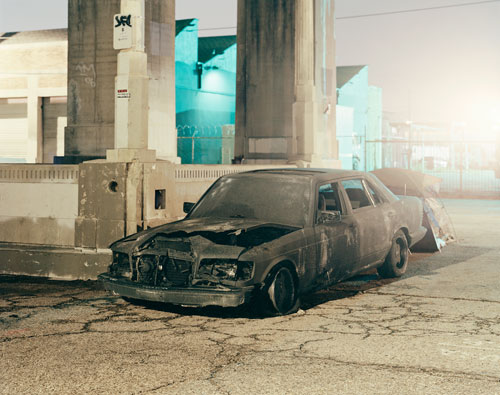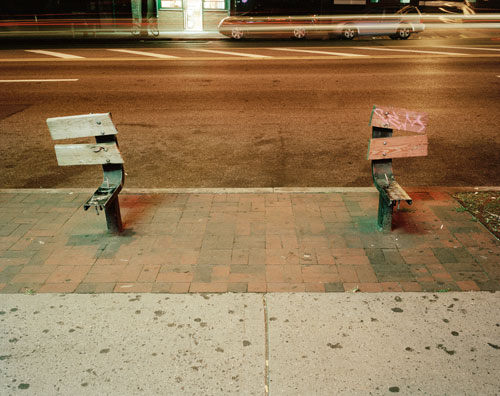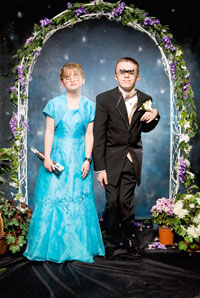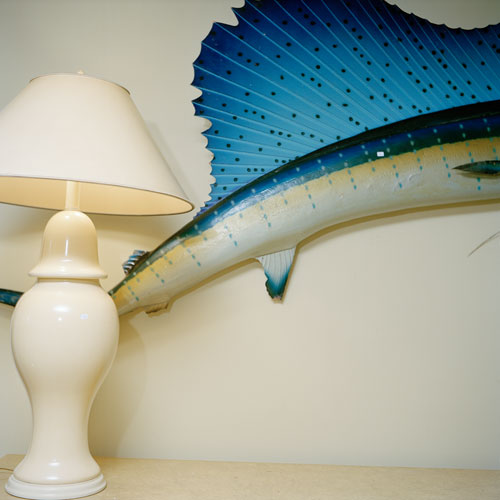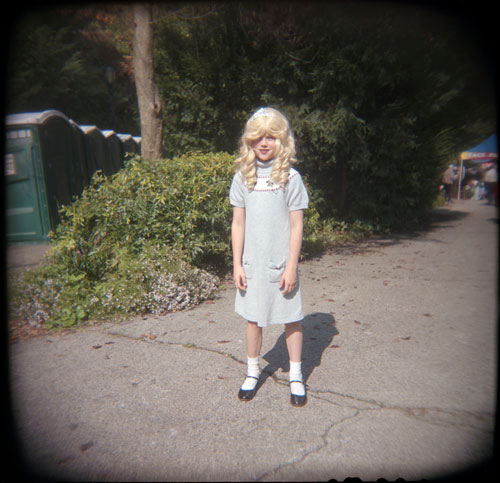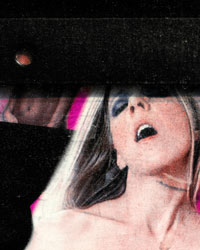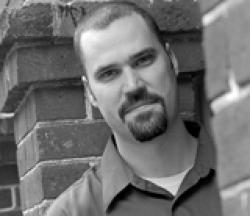A special issue of emerging photographers
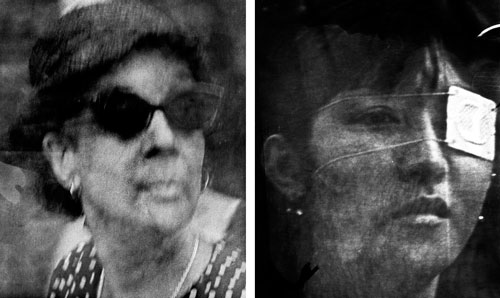
- Aaron McElroy - The series Doll-Drums uses a variety of techniques to distress the 35mm negatives and paper prints of the anonymous faces McElroy shoots on the streets of New York City. The transformed portraits suggest decay, wrinkles, even luminous dirt—and serve to present each person as a living doll.
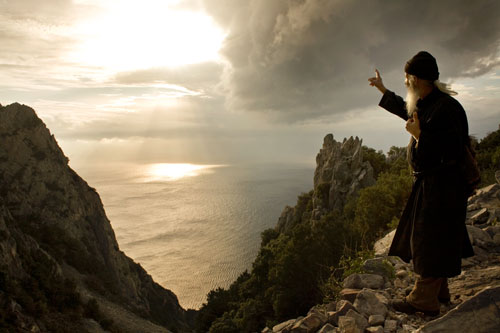
- Travis Dove - Dove traveled to Greece to document Mount Athos, a little-photographed, semi-autonomous monastic state and the spiritual center of the Orthodox Christian faith. The thirty-mile peninsula has been off limits to women for more than a thousand years, and in many ways life there has not changed since the Middle Ages. Father Kalistratos made the lifelong commitment to live on Mount Athos more than forty years ago. For the last eleven, he says, he has existed as a hermit, perched in a remote region of the mountain known by Athonite monks as “the desert.”
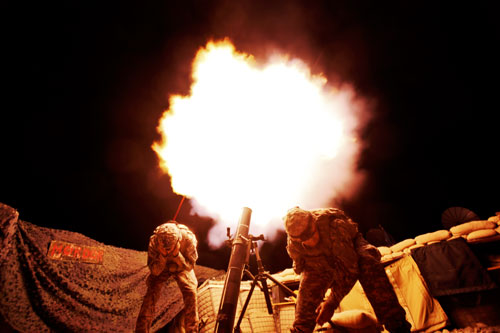
- Dima Gavrysh - Soldiers from the US Army’s 3rd Battalion, 509th Infantry Regiment (Airborne), based at Fort Richardson, Alaska, duck away from the blast of a 120mm mortar during a fire mission at the combat outpost Zerok in East Paktika province in Afghanistan, September 23, 2009. Gavrysh’s photographs seek to question whether civilization can be advanced through warfare.
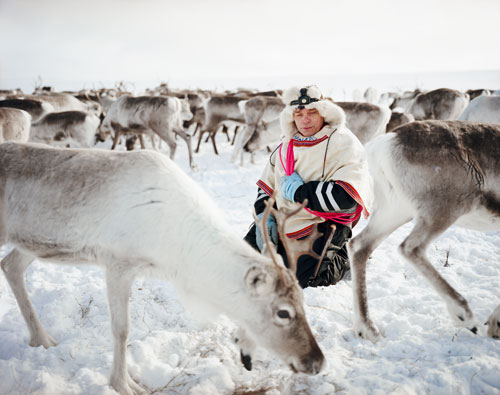
- Erika Larsen - Reindeer herder Nils Pedar A. Gaup sitting with his reindeer in Kautokeino, Norway. Larsen’s photographs of the Sámi, the indigenous people of northern Scandinavia, explore the relationship between their ancestral way of life, based on the seasonal migrations of animals, and the increasing temptations and conveniences of the modern world.

- Justin Maxon - Maxon’s series When the Spirit Moves uses multiple exposures to reveal the specters that haunt inner city Chester, Pennsylvania. Doretha “Rita” Washington, sixty-six, grieves at the casket of her younger sister, Kathy Ann Stewart, who was killed by a stray bullet while lying in bed talking to her fiancée. After her death, a group led by one of Stewart’s outraged family members, organized a walk around the project for seven straight days in protest of the violence.
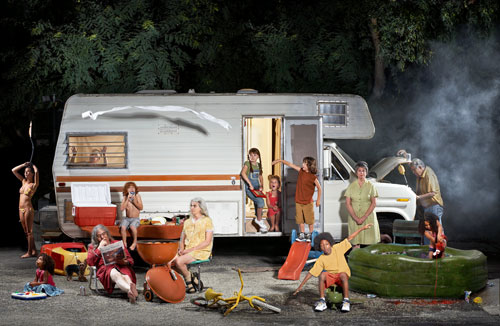
- Ryan Schude - Since 2007, Schude has been shooting an ongoing series of tableaux in and around Los Angeles, each image evoking both the verisimilitude and artificiality of movie sets. In “Bago 2008,” the necessary props were assembled weeks before the shoot date and characters were cast with this scene in mind, but only on set were interactions determined. The girl pouring out ketchup and the boy throwing toilet paper are examples of the kind of improvisation that becomes integral to this style of narrative.

- Cara Phillips - In 2006, Phillips set out to make a collection of photographs that would simultaneously create a visual record of the beauty industry and force her to confront her own body issues. Over time, the project became less documentary, instead seeking to capture the emotional, psychological, and political significance of offering to transform young women into something more perfect.

- Matt Eich - Eich’s series An Altered State of Being forms a record of his daily life—extracting moments of beauty from an existence turned chaotic, ever since his girlfriend became pregnant when she was nineteen. Now twentythree, Melissa Eich stands in the doorway of her bedroom in Norfolk, Virginia. She juggles spending time with the couple’s two-year-old daughter, Madelyn, and her graduate studies.
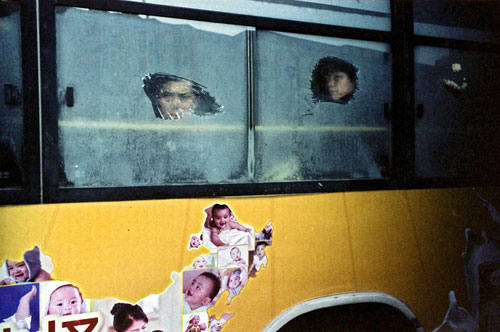
- Passengers on a bus in Daqing, part of Michael Christopher Brown’s visual travelogue of his travels across China.
In summer 2007, Erica Smith, a multimedia producer and print designer at the St. Louis Post-Dispatch, started tracking layoffs and buyouts in the newspaper industry. By her tally, more than 35,000 newspaper professionals have lost their jobs since then—and the numbers for magazine and book publishing are almost as bad. By some estimates, more than 100,000 jobs have been lost in print media since the beginning of the current recession. Nothing seemed to crystallize our moment more potently than seeing David Carr, the media critic for the New York Times, summarize the dearth of likely buyers for Newsweek by suggesting that the only motivations left were “nostalgia and a desire for civic engagement.” When nonagenarian financial mogul Sidney Harman bought the company, he was hailed as a savior of print media, but he wasted little time wedding Newsweek to Barry Diller-owned website The Daily Beast—the very kind of web aggregator and blog-based chattersite that has been the undoing of old media weeklies. Carr sardonically noted, “Gee, that sounds like a very unusual animal, one that has the head of a goat and the backside of a cow.” Such are the times we live in.
And yet, we’re not about to join the brigades of those tolling the bells for the death of print and journalism and long-form narrative and American intellectualism and all that we hold holy. Indeed, this special issue, dedicated to showcasing the finest emerging photographers, grew from a shared belief that the rising generation of documentarians aren’t about to let their sophisticated brand of storytelling—either textual or visual—die out any time soon. In fact, we are increasingly seeing young storytellers with multiple skills as photographers, writers, audio and video producers, and multimedia editors. Their ability to conceptualize, organize, fund, and carry out projects is more singular—but also more solitary—than at any other time in history.
In June, the LOOK3 Festival of the Photograph in Charlottesville assembled an incredible group of young photographers on a farm outside town for a two-night event called LOOKbetween. The weekend was designed to showcase early-career talent and bring the presenting artists into conversation with media professionals on practices and trends influencing the direc tion of photography today. But this was not another instance of young go-getters being told how to do things by old veterans. LOOKbetween turned the traditional mentorship model on its head and let the next generation of photographers, editors, publishers, curators, and media professionals share their vision for the future. This was a chance for the establishment to listen and to chart new courses to make their operations more nimble, more effective, and better able to take advantage of the incredible talent emerging from the new generation.
The atmosphere on the farm was relaxed and bucolic. The assembled photographers pitched tents in an open field on a hillside overlooking the bank of a swimming pond. Their work was shown at night on a temporary screen erected on the other shore. Lighted torches mounted on fence posts lit the way. Yet, for all the country charm of the weekend, the mood was decidedly electric. The photographers were elated to be in each other’s company, to be showing their work and seeing the work of their cohort, to be heard and to hear the challenges faced by editors and industry leaders in a publishing landscape that barely resembles the print world of even a decade ago. But there was nothing elegiac about the tone, nothing mournful or pessimistic. The tone was determined, not despairing—ready to roll up sleeves, not throw in the towel.
The photographs in this issue—and the stories of how they were taken—reveal that level of ingenuity and commitment. Whether it’s Tom Peschak getting a job at Save Our Seas to underwrite his work on sharks and rays or Andrea Gjestvang getting a grant from the Freedom of Speech Foundation to fund her travel to Greenland, the several photographers who received grants from the National Geographic Society or the ones who maxed out their credit cards, every one of these young photographers has found a way to keep their passion projects going. The images collected here are compelling proof that there’s no truth to the myth that the industry is suffering a crisis of content. The storytellers are here and willing to put all else aside—financial gain, personal lives, their own safety—in order to tell these stories. It is not a crisis of content but a crisis of courage—courage on the part of foundations and donors, courage on the part of magazines (both in print and online), and courage on the part of readers.
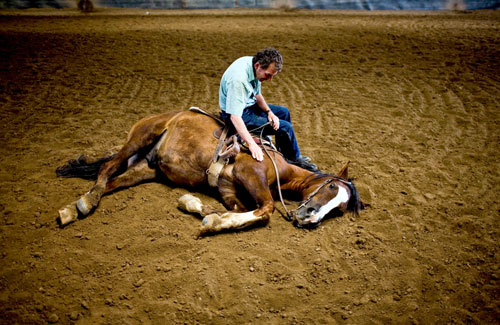
- Matt Slaby - Tony Brunetti sits on top of his wild mustang, Brooklyn, after only nine weeks of training. Brunetti is preparing the horse for the Extreme Mustang Makeover, an event in which top trainers have one hundred days to transform a wild mustang into a show quality horse. This particular trick, laying down a horse, is considered difficult by many trainers because of a horse’s natural instinct to remain standing in order to protect itself from predators. The photograph is part of the series The Last Good Kiss: A Lovesong to the American West.
LOOKbetween and this issue of VQR are the first of what we hope will be a growing series of meaningful collaborations aimed at identifying backers, encouraging publishers, and developing an engaged audience. We believe that the livelihood and strength of American democracy depends on the distribution of accurate information, and we seek to support aspiring photographers, as well as writers, who recognize that traditional on-the-ground, in-depth reporting and long-form storytelling remain vital, especially in the age of new technologies reshaping journalism. But carrying that tradition into the future is going to require new ways of thinking, new models of operation. LOOKbetween was made possible by combining corporate support with nonprofit donations, particularly from BD and National Geographic. The publication in VQR, by a special grant from the Office of the Vice President of the University of Virginia (the magazine’s new home), brings higher education into the equation.
With so many commercial publishers struggling to break even and so many old and venerable newspapers and magazines closing their doors, it’s only natural that the publishing world is starting to consider new modes of collaboration and cost-sharing and even talking seriously about nonprofit models and creating foundations to back their publishing. At this rare moment, colleges and universities are in a position to save American literature and forge new forms of journalism for our century. If we accept Carr’s dichotomy, then higher education has a crucial role to play, in building models based on civic engagement, not nostalgia for the era of advertising.
The University of Virginia’s founder Thomas Jefferson had a notoriously contentious relationship with media—once grousing, “Advertisements contain the only truth to be relied on in a newspaper”—but even Jefferson made clear that he considered the wide distribution of accurate information to be the cornerstone of our country. In 1787, in a letter to Edward Carrington, Jefferson wrote: “The basis of our governments being the opinion of the people, the very first object should be to keep that right; and were it left to me to decide whether we should have a government without newspapers or newspapers without a government, I should not hesitate a moment to prefer the latter. But I should mean that every man should receive those papers and be capable of reading them.” This last sentence, too often excluded when quoting this famous letter, strikes us as the central challenge of our time—not just for writers and photographers, editors and producers, but for anyone who cares about truth. We must endeavor together to find ways of assuring that these essential stories are available to everyone and a part of public discourse.
Until then, these young photographers are the standard-bearers. They not only keep alive but advance the ancient art of storytelling—the narratives that help us to understand our world, our communities, and ourselves. They carry this tradition into a new era and imbue it with renewed energy and honesty. Their images—like drawings on the cave wall, like the brush strokes of the great masters—remind us of our shared and fragile humanity. They tell us who we are and who we might be. For those of us who thrill to a well-shot frame, this is an opportunity to delight in what this next generation of photographers can do, but it is also a charge to match their energy with our own—to assure their images are seen, that their stories are heard.
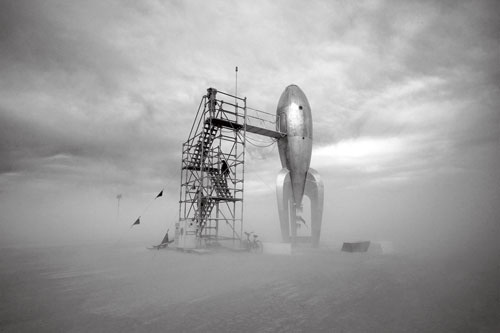
- Peikwen Cheng - Since 2000, Cheng has made an annual pilgrimage to the Black Rock Desert in northern Nevada for the Burning Man festival. There, in the middle of a prehistoric lakebed ringed by mountains and covered in dust, a community gathers to imagine, build, and share a waking dream. Cheng’s series Lost and Found, including “Launching Out of Oblivion,” creates otherworldly images from this real-life festival.
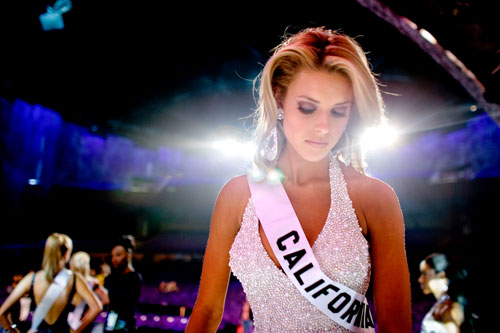
- Jenn Ackerman - Carrie Prejean, Miss California, walks off stage during the Miss USA 2009 pageant. After being named first runner-up, Prejean was stripped of her crown for alleged breaches of contract. Ackerman’s series Chasing the Title of Miss takes the viewer behind the scenes at two of the largest pageants in the world—Miss USA and Miss Universe. It reveals a world of sashes, makeup, curlers, artificial enhancement, and high heels—all in pursuit of being named Miss for a year.
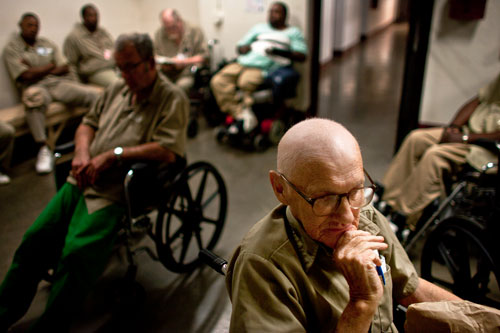
- Tim Gruber - Gruber’s series Served Out takes us inside a world of inmates made prematurely aged by life in prison. Many struggle with simple tasks, like remembering the date, feeding themselves, or even leaving their beds. Here, Roy Dunn, sixty-three, waits in a holding area at the Kentucky State Reformatory in La Grange for his ride home after receiving “shock probation”— a controversial program of releasing prisoners after short incarcerations, in hopes that brief terms may be as effective as long sentences.
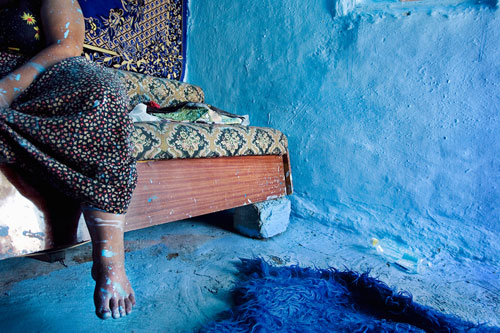
- Myrto Papadopoulos - The series Kalé documents the Greek Muslim families living in the caves below the ruins of the Byzantine castle that once encircled the town of Didimoticho on the northeast border of Greece and Turkey. This isolated cluster of dwellings is its own tiny world, dense with colorful rugs, animals, and satellite dishes. Every summer each family paints their home to clean it but also to redecorate.

- Ed Ou - Somalia has been mired in civil war for almost twenty years. Ou’s series Children of Men captures the lives of the war-torn country’s young people—born with few options and little hope. Here children recite the Koran in an Islamic madrassa in the Hamar Weyne District of Mogadishu in January 2010.

- Will Steacy - The series Down These Mean Streets examines the collapse of the postindustrial inner city where years of neglect have left local governments with limited resources and allowed neighborhoods to crumble. By addressing the loss and despair that prevail in our urban communities, Steacy creates a tough and clear-eyed portrait of modern America.

- Sarah Wilson - Prom is an important rite of passage for the American teenager, but it is equally significant for students at the Texas School for the Blind and Visually Impaired. For the last four years, Wilson has volunteered as the school’s prom night photographer. The resulting portraits capture moments of unguarded joy and encourage the viewer to consider what life might be like as a blind teenager.
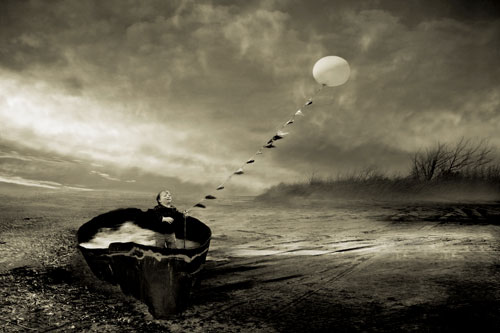
- Angela Bacon-Kidwell - Bacon-Kidwell’s Traveling Dream is a series of unresolved moments—in media res fables for which each viewer must imagine a personal beginning and end. In this way, the images don’t so much build a narrative as invite us to create our own dream story.

- Lisa Wiltse - Maria Peters, fifteen, holds her newborn baby sister at their home in the Mennonite settlement of Manitoba, in eastern Bolivia. Wiltse went to photograph Manitoba after allegations surfaced that more than a hundred women and girls there had been drugged with a narcotic and then raped by men in the village. The charges shattered the tranquility of the settlement where many teenage victims now fear they will be unable to find husbands because the Mennonite community requires that its women remain virgins until marriage.

- Anna Maria Barry-Jester - Tanya Martinez Toval, fourteen, and her sister Sulema, twenty-five, butcher a pig to sell in their community. Barry-Jester was drawn to Chichigalpa, Nicaragua, to document an epidemic of kidney disease that has killed many of the men in the area, including Tanya’s father. The community is now locally known as La Isla de las Viudas—the Island of Widows.
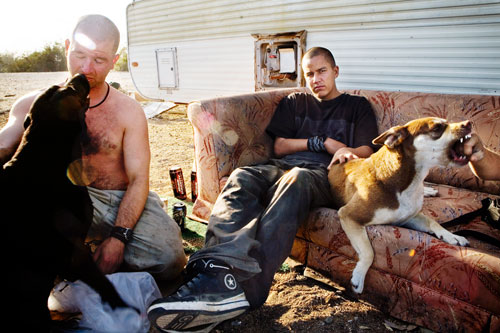
- Daryl Peveto - In Slab City, located on the Salton Sea in southern California, there are no amenities or services, no potable water, no electricity, no stores, nothing. Judd Jones sits on his couch with his dog Coco while best friend Dave Hines kisses his dog, Blackie. Both men suffer from Fetal Alcohol Syndrome and medicate themselves with whatever they can find. On this day, it was malt liquor stolen from the nearby market. Jones was arrested later that day for an outstanding warrant for raping his mother and setting her trailer on fire with her in it. At first glance, this community is both raw and harsh, but there is also much beauty and love. There are thieves and rampant drug use but also picnics and birthday parties and an always-open door.
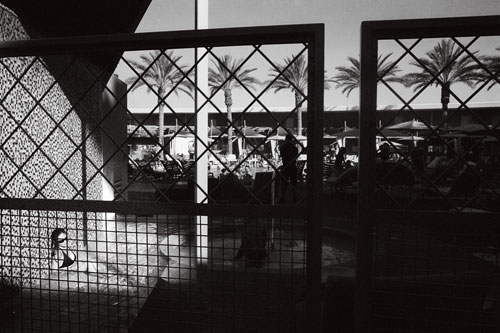
- Brian L. Frank - Sitting in the lap of luxury, a woman sunbathes in a pool near Phoenix, Arizona, in temperatures near 115° F. The swimming pools and suburbs of Phoenix would not exist without the water of the Colorado River, which stretches over 1,400 miles from its origins in the northwest United States to the Sea of Cortez in Mexico. The waterway is dying as overpopulation and damming suck it dry in the north, while pollution on both sides of the border and global warming affect it in immeasurable ways.
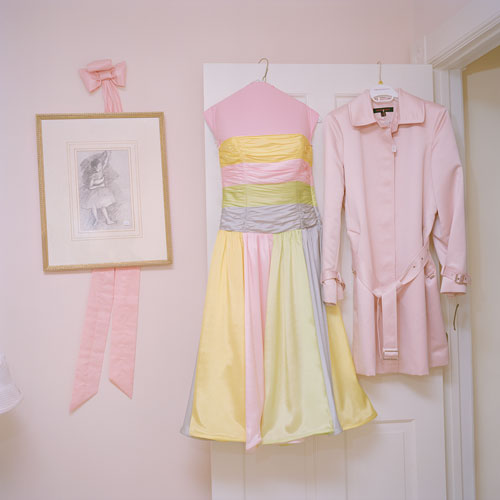
- Sarah Girner - Estate sales mark the last time a household of possessions remains intact, the final moments of a home. Girner’s series The Transience of Things records those two days of suspended reality and hints at the preceding rupture—a death, a divorce. Each room tells a story.
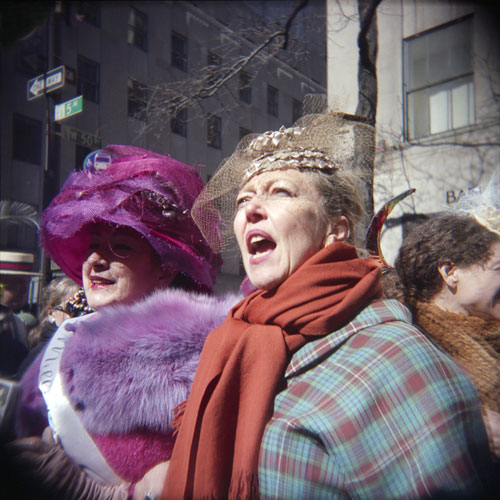
- Chae Kihn - The series Fragmented Evidences, shot in New York City from 2009 to 2010, reveals Kihn’s interest in the way the camera lens frames but cannot contain reality. Photographs can only capture parts of things, individual moments, never anything in its entirety. Kihn’s photographs demonstrate how even slight distortions of color and form can create an entirely different understanding of the world.
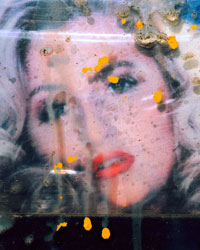
- Nathaniel Ward - After the Women of Paradise Road appropriates the covers of adult periodicals distributed in the magazine vending boxes that line Paradise Road in Las Vegas. Shot through the boxes’ weathered and sun-bleached plastic windows, the images speak to a culture of desensitization and reveal tropes of marketable lust that include the necessary anonymity of the sexual object, the disposability of desire, and the sectioning of the human body into saleable parts.

- Paul Octavious - For the past two years Octavious has visited the same mound of earth that he identifies only as “the hill.” Each time he goes to the hill, he finds a new story to tell, as if the hill is his stage and the locals are the actors in this daily play. One day the hill is a backdrop for a fireworks display; another over two hundred people gather to fly kites of all different kinds. And over the course of a year, the hill transforms from soccer field to the perfect slope for sledding.


